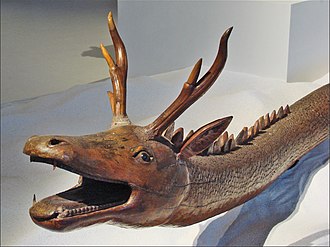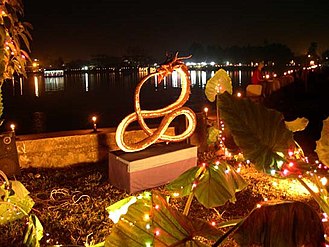Pakhangba
Pakhangba (Meitei: ꯄꯥꯈꯪꯕ) is a primordial serpentine dragon god in Meitei mythology and religion.[1][2] He is present in the heraldry of Manipur kingdom, originated from "Paphal" (ꯄꯥꯐꯜ), the mythical illustrations of the deity belonging to the traditional beliefs, preceding Hinduism in Manipur.[3] Among the Meiteis, it is believed that the ancestor of one of the clans manifested himself as the Pakhangba.[4][5][6]
| Pakhangba | |
|---|---|
Primordial serpentine dragon god | |
| Member of Primordial Meitei deities | |
 | |
| Other names | Pakhangpa, Apanba (Apanpa) |
| Meitei | ꯄꯥꯈꯪꯕ |
| Affiliation | Sanamahism (Meitei religion) |
| Abodes | Heaven and Earth |
| Mantra | Hum! Hum! Hum! Um He Khoyum Lainingthou Pakhangba! |
| Symbol | Serpent (symbolism) |
| Texts | PuYas |
| Gender | Male |
| Ethnic group | Meitei ethnicity |
| Festivals | Lai Haraoba |
| Personal information | |
| Parents |
|
| Siblings | Lainingthou Sanamahi, Nongshaba and Nongthang Leima |
| Consorts | Lai Nura Taret (Seven celestial goddesses) |
| Children | Mangang, Luwang, Khuman, Angom, Salai Leishangthem, Kha Nganpa and Moilang. |
| Equivalents | |
| Greek equivalent | Typhon |
| Hinduism equivalent | Ananta Shesha, Vasuki, Takshaka |
The identity of the deity is often fused with "Nongda Lairen Pakhangba" (33 AD-154 AD), the first ruler of the Ningthouja dynasty, to sit on the throne of the Kangla Palace.[7][8] The title Pakhangba was also used by other royalties in the history of Manipur.[9][10]
In heraldry[]
A Pakhangba as a heraldic dragon was present in all the former royal flags and coats of arms of Manipur. The kingdom of Manipur had a set of two flags, a white one and a red one. All featured the Pakhangba dragon in the centre, although not as prominently in the latter flags.[11]
Description[]
The Pakhangba is the supreme God. He is a man who can change his body to any form, like animals, and others as he is a powerful God. In certain sculptures, known as Kangla-Sa, at the citadel of the Kangla Palace in Imphal, there is a related type of creature represented with a short body. The sculptures are large and were built of brick, standing at each side of the northern gate. They have a similar head and four sturdy legs, but their body is shorter and bears more of a resemblance to a lion.
In 1891, during the Anglo-Manipur War five British officers were executed by Manipuri soldiers below these two Kangla-Sa. The act was a kind of magic ritual in which the blood of the white officers was seen as feeding there in order to weaken British power. For this act Major Maxwell, the Political Agent that was appointed after the war, had destroyed the two kangla-sa with gunpowder following the conquest of Manipur.[12]

Poubi Lai Paphal: a mythical form of Pakhangba

Lit Pakhangba statue in Imphal

Two standing Kangla-Sa at the northern gate of Kangla Fort. These massive statues have been rebuilt after they were destroyed at the end of the Anglo-Manipur war of 1891.
See also[]
- Lists of deities in Sanamahism
- Dragons in Manipuri mythology
- History of Manipur
- Kangla Palace
- Ningthouja dynasty
References[]
- ^ "The Manipuri Lais".
- ^ Bahadur, Mutua; Santabai, Y. (1989). "Tribal Art of Manipur".
- ^ Samiti, Kāmarūpa Anusandhāna (2007). "Journal of the Assam Research Society".
- ^ "Proceedings of North East India History Association". 2001.
- ^ Bahadur, Mutua; Santabai, Y. (1989). "Tribal Art of Manipur".
- ^ Hastings Encyclopedia of Religion and Ethics, Volume 11
- ^ Nayar, V. K. (2005). Crossing the Frontiers of Conflict in the North East and Jammu and Kashmir: From Real Politik to Ideal Politik. ISBN 9788175412187.
- ^ Jain, Jyotindra (1998). "Other Masters: Five Contemporary Folk and Tribal Artists of India".
- ^ Samiti, Kāmarūpa Anusandhāna (2007). "Journal of the Assam Research Society".
- ^ A Brief history of the Meeteis of Manipur - The Manipur Page
- ^ FOTW - Manipur, Indian Princely State
- ^ KanglaSha : The story behind the Legend
External links[]
 Media related to Pakhangba at Wikimedia Commons
Media related to Pakhangba at Wikimedia Commons- Paphal: the mythical assumptions of Lord Pakhangba, ruling deity of Manipur
- Mythological hybrids
- Dragons
- Culture of Manipur
- Gods and goddesses of Kanglei mythology
- Mythology



